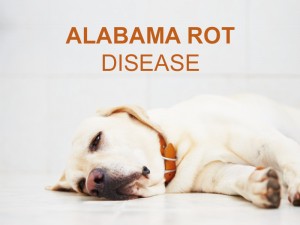
Alabama Rot Disease

Alabama Rot Disease, scientifically known as cutaneous and renal glomerular vasculopathy, was first identified in the USA in the 1980s, affecting almost exclusively greyhounds. In the UK, the first reported cases were from the New Forest Area but more recently new cases of this disease have been described throughout the UK. The cause of Alabama Rot Disease is still unknown and it's currently under investigation.
Affected dogs start by showing skin lesions, sores, wounds, and blisters, especially on their face or limbs. Over the next 2 to 7 days, they can develop acute kidney failure which can lead to death. At this stage the dog may be vomiting and lethargic.
Considering the cases that have been reported so far, it doesn't seem to exist any breed, body weight, sex or age predisposition for this disease.
Through clinical signs, history and blood test results, vets can suspect a dog is suffering from Alabama Rot Disease, but unfortunately a definitive diagnosis can only be made through pathology results obtained from an animal that has passed.
Although scary and serious, this disease is not common and chances of a full recovery increase if a dog is treated early. The number of dogs affected with skin lesions and kidney failure remains low (56 confirmed cases across the UK between November 2012 and May 2015). Most of the times a skin problem will not be caused by Alabama Rot Disease and even if the skin changes are caused by it, many dogs will not develop kidney problems and will have a full recovery.
Since the cause is still unknown there aren't any preventive measures we can recommend. If your dog has blisters or ulcers anywhere in his or her body bring him or her to the vet. Please remember that dogs treated in the early stages of this disease are more likely to have a better prognosis!
Would you like to know more about dogs? Check our Canine Courses:
Canine courses
Published: 11 Feb 2016
Read the previous article: Overweight cats

